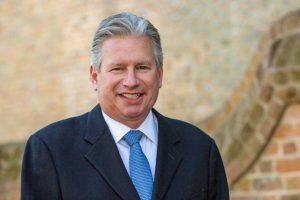A Masterpiece in the Making
 This past February, the Orlando Museum of Art (OMA) announced Aaron De Groft, Ph.D., as its new director and CEO. An expert in the field, De Groft previously served as the deputy director and chief curator of the John and Mable Ringling Museum of Art. More recently, he was the director and CEO of the Muscarelle Museum of Art at his alma mater, the College of William & Mary, in Virginia. De Groft has also authored several books. Orlando Family Magazine recently spoke to De Groft about his love of art, the rebranding of the OMA, and what is ahead for the museum.
This past February, the Orlando Museum of Art (OMA) announced Aaron De Groft, Ph.D., as its new director and CEO. An expert in the field, De Groft previously served as the deputy director and chief curator of the John and Mable Ringling Museum of Art. More recently, he was the director and CEO of the Muscarelle Museum of Art at his alma mater, the College of William & Mary, in Virginia. De Groft has also authored several books. Orlando Family Magazine recently spoke to De Groft about his love of art, the rebranding of the OMA, and what is ahead for the museum.
How did you become interested in art history?
I majored in art history and architecture at the College of William & Mary. During that time, I was playing varsity baseball and was in a fraternity so, believe it or not, academics was not at the top of my list of interests. That was until the universe reached out, smacked me in the face, and I tore up my knee playing intramural volleyball. After recovering, I tried to come back and play baseball but that didn’t happen. It ended up being a good thing, though, because I probably would not have made it out of college; William & Mary is one of the toughest schools in the country and I had a lot of distractions. Once I realized I wasn’t going to be able to play baseball, I hobbled into the campus art museum, The Muscarelle Museum of Art, which was new at the time. There was a young, dynamic director there, Glenn Lowry, who today is the director of the Museum of Modern Art in NYC. I told him that I wanted to learn the museum business from the bottom to the top and he said, “OK, start by painting that wall.” So, I began doing things like painting, hanging lights and works of arts, and matting frames. Then he started asking me to research a couple of things which I really enjoyed. It was an eye-opening experience. Funny thing is, years later I went back to be the director of that museum.
Do you have a favorite artist or work of art?
That’s a very difficult question to answer because there are a lot of artists that I really like a lot. In terms of abstract expressionism, Franz Kline is one of my favorite artists. I think one of the truly astounding works of art is Michelangelo’s Pietà in the Vatican. That sculpture is beyond amazing. Another one of my favorite sculptures is by Gian Lorenzo Bernini. The sculpture depicts Pluto grabbing Proserpina and though it is made of marble, it truly looks like flesh because Pluto’s fingers are indented into the thigh of her leg. The third one is Michelangelo’s very last work, the Rondanini Pietà. Every time I see it, I cry. It’s that powerful.
You have served as director and curator for several incredible art museums. What drew you to the Orlando Museum of Art?
I’ve been very lucky in my life to have worked at places that have meant a lot to me, both historically and emotionally. I was at The Ringling in Sarasota for 11 years. I was at my alma mater, William & Mary, for 14 years and a couple of great places before and in between that. About a year ago, I took a flight from Richmond to Sarasota to visit some dear old friends. That visit reminded me of just how much I love Florida. I told my wife Lee, “We need to get back to Florida because when you live in a place as beautiful as this, it’s hard to be in a bad mood.” The very next day I flew back to Richmond, and on my drive home from the airport I received a phone call from a recruiter asking if I would be interested in working with the Orlando Museum of Art, and immediately said yes. I had turned down a couple of other opportunities but I think Orlando has so much unrealized potential and to be only the fourth director of OMA’s nearly 100 years says a lot about this museum.
What sets the Orlando Museum of Art apart from other art museums?
Well, we are trying to change the culture here and I think we’ve done pretty well with that so far. We are a world-class art museum in a global city. It is not without serious recognition that Orlando is one of the most heavily visited cities in the world. Between some efforts of the airport and other marketing endeavors, we have basically quadrupled our marketing budget and are eagerly trying some new things. We have added new staff and more firepower to our marketing and advertising. We are the oldest art museum in Florida. Some have said the Tampa Museum of Art is the oldest but they were originally more of an arts group not an institute. Orlando Museum of Art has been an art institution since 1924, making it one of the top three oldest art museums in the south, next to Savannah and Charleston. This is not insignificant. Florida has deep roots and much tradition. Orlando has the brand of a winner and so do we.
What changes are coming to the OMA?
Through the exhibitions that we are opening and this aggressive relaunch, we are really changing the brand of the museum. Every director before me was an artist of some sort. I’m an art historian. In the past, OMA had been visually self-identified with contemporary art. We are working to change this. For me, it’s about consciously giving back to the community. It’s like running a restaurant—who wants to have a menu with all the same flavors? We will still have contemporary art but we are incorporating exhibits such as old European master paintings, and diverse photography as well as looking into costume exhibitions, French impressionism and Greek antiquities, all in an effort to be more broadly comprehensive.
What current and upcoming exhibits will visitors have to look forward to?
We currently have two very different photography shows. One is a Bank of America collection on Mexican photography. The other one is called Cathedrals of Florida, with works by Clyde Butcher, who has spent almost his entire career in Florida and is probably the most significant American landscape photographer alive today. The pictures are gigantic, 9 foot by 5 foot, in the smallest room we have because they are meant to overwhelm you. I’m also doing a free series of lectures on connoisseurship, discussing how we acquire all of this amazing art, like how we bought a Peter Paul Rubens painting on panel for $25,000 and then it got insured for $20 million at an exhibition of early Ruben. We are also really excited about the Basquiat exhibition that will open in February and the never-before-published Jackson Pollock painting that’s coming in April. We will also have an incredible Michelangelo exhibition next summer. So, we have a lot of exciting things coming up and all of this is done with a strategic eye on our 100th anniversary, in 2024, as well as with the hope of expanding downtown—not moving, but expanding in downtown Orlando.
What can you tell us about some of the programs offered at OMA?
Even while I was at The Ringling in Sarasota, it was common knowledge that the programs at the OMA were top-notch. This past summer, we had a record-breaking number of kids attending our art camps. We have an extensive landscape of programs for people of all ages. In addition to the art classes and docent tours we offer, we have programs for families, stroller tours, Art Night Out, and on the first Thursday of every month visitors have the opportunity to discover local artists. The slate is gigantic. These events are getting branded more solidly and I’m very proud of the efforts of our marketing team. For example, we are going to wrap a bus in Basquiat art, and we will have a full-page ad in The New York Times. We are very keen and knowledgeable at managing our brand, but manage it we have to. We are trying to bring more exceptional art and programs to our community and some may think we are punching above our weight class but our weight class is to be a world-class art museum in a global city.
What would you like Central Floridians to know about OMA?
We welcome everyone here. To be able to walk into a beautiful place with this magnificent Dale Chihuly tower that simply glows at night, is something for our community to be really proud of. We truly have something for everyone. If you go back to the origins of what a museum really is, it is a place for people to gather, discuss and debate and we want to further that. We want the community to be proud of OMA. I want to live in a town with enough beckoning power to bring the works of one of the greatest artists in the history of the world, Michelangelo, to our community. We take our relationship with the public very seriously. If you ask me what I do, I say I run a multimillion-dollar downtown business, because that’s exactly what we are but our mission is all about experiential learning.











